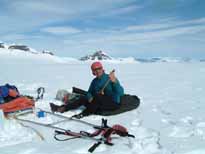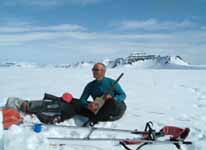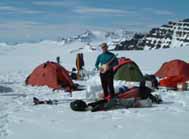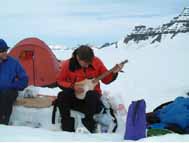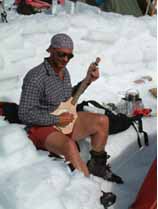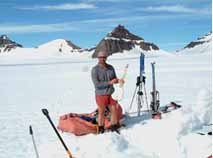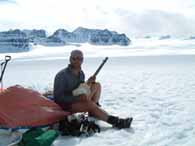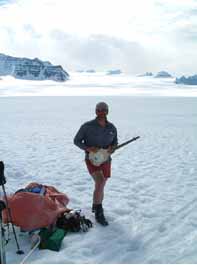Here's the full text of Phill's report: (my comments are in red [sdf])
Aim
To provide rigorous test conditions for a folding travel banjo to determine its durability and usefulness as a quality practice instrument for serious players on the move.
Trial Conditions
The Tranjo made the journey from the US to the United Kingdom, and then on through Iceland to the glaciers and ice cap of Greenland. The return journey took the reciprocal route.
The Tranjo was transported around Greenland for 15 days where it was exposed to variations in temperature, rough handling on sleds and in rucsacs, came into contact with snow and ice, and survived an arctic storm.
Travel from UK to Greenland via:
London (Stanstead) Airport to Reykjavik Airport (Iceland)
Reykjavik to Isafjordur. Airport in north west Iceland by Fokker 50.
Isafjordur to Greenland by Twin Otter aircraft to land on glacier at 7000 feet.
Return journey reversed.
The Tranjo was packed in small black padded case for the outward and homeward journeys. Whilst in Greenland, it remained fully assembled and was transported with the neck of the Tranjo sticking out of the black padded bag.
The Tranjo was treated to a number of tests: being posted from the US to the UK and back again, being bundled into taxis, onto buses, given normal treatment at international and local airports by baggage handlers, crammed into a cargo hold along with other bags and cases (not cabin luggage), transported on a sled across glaciers, carried in a rucsac, and kept in a tent with no special treatment.
Temperatures varied from minus 12 deg C to plus 27 deg C.
The air was fairly dry throughout. High humidity was not experienced.
The Tranjo suffered no known major bangs, drops of subject to liquid spillages.
Comments
I enjoy adventurous activities and regularly go off climbing mountains or taking a long canoe trip, or going for an adventure holiday. For some time now, I have been searching for a travel banjo to join me on those adventures but it had to be small enough to be able to get into a flight bag or carry in a rucsac. Other travel banjos seemed to be simply smaller versions of the real thing and I did not feel that they would be robust enough to meet the demands placed by real travelling. I also wanted the neck to have regular fret spacing so that it would have the real banjo feel, making the practice worthwhile and realistic. The Tranjo seemed to meet these needs and with this in mind, I got hold of one and took it on a ski-mountaineering and climbing trip to Greenland. I was not disappointed.
The Tranjo survived all that was thrown at it. It proved reliable, and robust. With the machine heads placed inside the back of the instrument, there was no danger of them being knocked off inadvertently during normal handling and a trip of this nature. This was one of my severe doubts about other travel banjos.
The sound seems muted after playing a banjo with a resonator but when you are holed up with others in a tent in a storm, or sharing hostel accommodation with strangers in a foreign land, this is a distinct advantage to enduring social relations with your neighbours. The small fibre skin head also proved ideal in temperatures that fluctuated daily above and below freezing. A regular white frosted drum head gives better volume and tone. My sound clips were recorded with the regular head. The Fyberskin head was an experiment [sdf]
I found the action a little high but use of the capo brought it down to a level I was happy with. I could have played around with the set up or the bridge but chose instead to use the capo as the quick option.
The production Tranjo has a separate neck mounting block, so the neck angle can be adjusted without affecting the head tension. The action is now much lower, as well as more stable [sdf]
I had to change the 1st and 5th string once each on the trip and found this a little fiddly, certainly the first time. I think that you would soon get used to it though regular handling and use. When I first assembled and used it, tuning also seemed a bit fiddly but I soon got used to this and once mastered , the Tranjo held its tuning well, even when regularly shifting from 3-finger style in open G to clawhammer style in double C or other open tunings.
Conclusion
This is a very durable and playable instrument. It can clearly cope with the rigours of real and arduous travel to far flung places on the earth. It is easy to assemble and playing has the feeling of a real banjo.
Not the prettiest instrument but a very effective companion on those out-of-the-ordinary trips as well as regular travel on holiday, to the beach or routine business travel.
The production Tranjo is very nice looking -- no handmade cuts and a better selection of maple. [sdf]
Sam - some further comments for your consideration:
Need 4 posts not 2 to hold strings separately to assist in string changes. The production Tranjo ships with ball-end strings which make it very easy to change individual breaks. There are still only two posts if you want to use loop end strings [sdf]
Strings breaking due to getting trapped between rollers. There are now individual slots for each string, and the rollers are profiled to reduce side-to-side slippage [sdf]
Neck spikes worked loose in cold conditions and lifted under the tension of the 5th string. Again, my lutherie inexperience showing [sdf]
String spacing uneven at nut. The production Tranjos are computer machined to very precise tolerances -- this is no longer a problem [sdf]
I found the action quite high and preferred to use the capo at the 2nd fret in order to lower it. The production Tranjo has a separate neck mounting block, so the neck angle can be adjusted without affecting the head tension. The action is now much lower, as well as more stable [sdf]
Would be helpful of mark correct position of bridge to speed assembly and setup. Easily done... [sdf]
Rollers need to be more tightly packed or consider alternatives such as the use of 5 semi-circular 3mm tube so that they capture the strings as they pass around the back of the banjo, rather than the current system which permits them to flop off the side of the roller and become trapped. The new string slot design and profiled rollers help prevent this [sdf]
